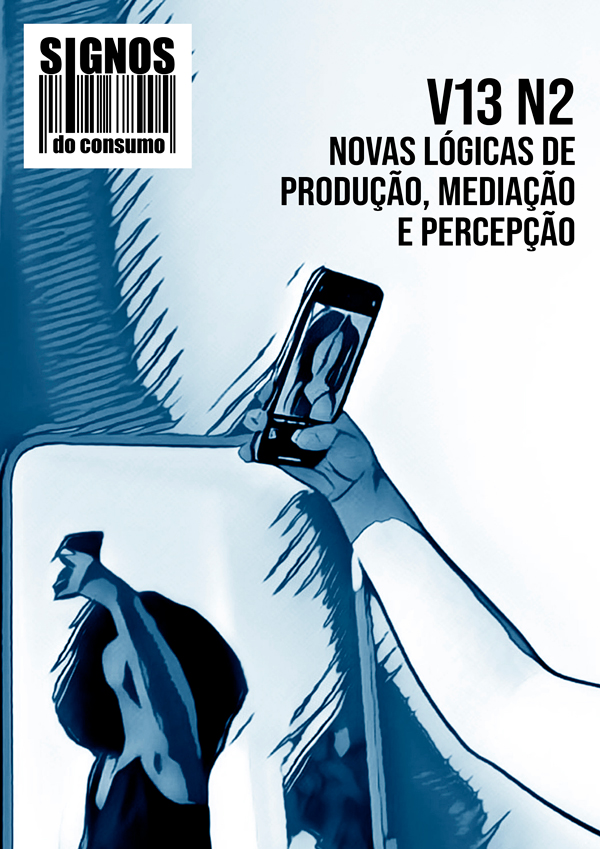The multiple meanings of contemporary television: language, content, medium, and subjectivity
DOI:
https://doi.org/10.11606/issn.1984-5057.v13i2e190425Keywords:
Hybridization, Television, Art, Construction of subjectivity, Therapeutic instrumentAbstract
This article seeks to articulate knowledge about television from a hybridized perspective of vehicle, language, and content, based on the theoretical propositions of De Botton and Armstrong for the understanding of art as a therapeutic tool. This approach allows for the expansion of the role of art in the construction of subjectivity for the universe of content in television production, putting it on par, as favorable potentiality, with the functions of art described by the authors – remembrance, hope, suffering, rebalancing, self-understanding, growth, and appreciation.
Downloads
References
ARISTÓTELES. Metafísica. São Paulo: Loyola, 2002.
BRENNAN, David. TV conectada: como as qualidades analógicas da TV criaram uma supermídia digital. São Paulo: Globo, 2016.
BRIGGS, Asa; BURKE, Peter. Uma história social da mídia: de Gutenberg à Internet. 3. ed. Rio de Janeiro: Zahar, 2004.
CHEVALIER, Jean; GHEERBRANT, Alain. Dicionário dos símbolos: mitos, sonhos, costumes, gestos, formas, figuras, cores, números. Rio de Janeiro: José Olympio, 1993.
DE BOTTON, Alain; ARMSTRONG, John. Arte como terapia. Rio de Janeiro: Intrínseca, 2014.
EAGLETON, Terry. Humor: o papel fundamental do riso na cultura. Rio de Janeiro: Record, 2020.
ECO, Umberto (org.). História da beleza. Rio de Janeiro: Record, 2004.
FARTHING, Stephen (ed.). Tudo sobre arte. Rio de Janeiro: Sextante, 2011.
GITLIN, Todd. Mídias sem limite: como a torrente de imagens e sons domina nossas vidas. Rio de Janeiro: Civilização Brasileira, 2003.
HAN, Byung-Chul. Sociedade da transparência. Petrópolis: Vozes, 2017.
HAN, Byung-Chul. Sociedade do cansaço. Petrópolis: Vozes, 2015.
JENKINS, Henry; FORD, Sam; GREEN, Joshua. Spreadable media: creating value and meaning in a networked culture. New York: New York University Press, 2013.
MACHADO, Arlindo. A televisão levada a sério. São Paulo: Senac, 2000.
MCLUHAN, Marshall. Os meios de comunicação como extensão do homem. São Paulo: Cultrix, 1964.
NEGROPONTE, Nicholas. A vida digital. São Paulo: Companhia das Letras, 1995.
PEREZ, Clotilde. A comunicação da completude: a busca do objeto do desejo. Revista Mackenzie: Educação, Arte e História da Cultura, São Paulo, v. 3-4, p. 109-116, 2004.
PEREZ, Clotilde. Há limites para o consumo? São Paulo: Estação das Letras e Cores, 2020.
PEREZ, Clotilde. Signos da marca: expressividade e sensorialidade. 2. ed. São Paulo: Cengage Learning, 2017.
SANTAELLA, Lucia. Comunicação ubíqua: repercussões na cultura e na educação. São Paulo: Paulus, 2013.
SANTAELLA, Lucia. Linguagens líquidas na era da mobilidade. São Paulo: Paulus, 2007.
SCHOPENHAUER, Arthur. Dores do mundo. Rio de Janeiro: Ediouro, 1985.
THINKBOX. The age of television: the needs that drive us. Thinkbox, London, 2018. Disponível em: https://www.thinkbox.tv/research/thinkbox-research/the-age-of-television-the-needs-that-drive-us/. Acesso em: 1 jun. 2021.
WEEMS, Scott. A ciência do humor. São Paulo: DVS, 2016.
WILLIAMS, Raymond. Televisão: tecnologia e forma cultural. São Paulo: Boitempo; Belo Horizonte: PUC Minas, 2016.
Downloads
Published
Issue
Section
License
Copyright (c) 2021 Roberto Schmidt, Clotilde Perez

This work is licensed under a Creative Commons Attribution-NonCommercial-ShareAlike 4.0 International License.
Authors retain copyright and grant the journal right of first publication with the work simultaneously licensed under a Creative Commons BY-NC-SA License.




